|
.
In 1812 one of the Polish lancers lost his headwear.
Jerzmanowski ordered him to go back and retrieve it
to prevent the enemy from claiming any trophy
taken from this regiment. It was unusual since many
French troops panicked before Cossacks and left
behind their wounded, weapons, not to mention
headwears.
|

1812: Invasion of Russia.
"As soon as a raport arrived that there were Cossacks about
the order would come down: 'Polonais, allez vous ! [Poles, off you go !]
It was a rare night indeed that we slept undisturbed."
- Officer Dezedery Chlapowski
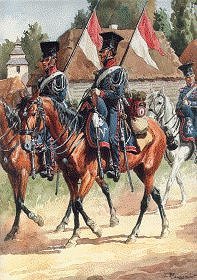 The regiment spent the winter of 1811-1812 very happily in Paris.
Chlapowski: "... the Emperor decided on his return from Holland to provide entertainment
for his much younger bride, and so every day there was a reception or ball, sometimes in the
Tuileries, sometimes at the house of one of his sisters ...
The regiment spent the winter of 1811-1812 very happily in Paris.
Chlapowski: "... the Emperor decided on his return from Holland to provide entertainment
for his much younger bride, and so every day there was a reception or ball, sometimes in the
Tuileries, sometimes at the house of one of his sisters ...
Finally, in April, war with
Russia seemed certain. We left our barracks in Chantilly in early May and marched to Theims,
then Verdun. There our Polish officers became very friendly with some Englishmen who were
on a private tour of the continent, and these men said they wanted France to defeat Russia
so that our country could be recreated. I met there a
Lord Blanchy, (ext.link) a Lord
Bogle, and some of their company. From Verdun we made for Longwy and the Luxembourg, which is
a very strong fortress with a large garrison. ... We then passed through some beautiful
country. The views around Trier in particular were fabulous. ... In Vilnius (Wilno) we were
idle for two weeks."
(Chlapowski, - pp 103-105)
The regiment was very strong and formed entire brigade.
The organization was as follow:
4th Guard Cavalry Brigade - GdB Wincenty Krasinski
 STAFF :
STAFF :
Colonel - GdB Jan Konopka
First Grosmajor - Pierre Dautancourt
Second Grosmajor - Dominik Radziwill
 
. . . . . I SQUADRON - Jan Leon Hipolit Kozietulski
 
. . . . . II SQUADRON - Dezydery Chlapowski
 
. . . . . III SQUADRON - Jan Pawel Jerzmanowski
 
. . . . . IV SQUADRON - Piotr Krasinski
 
. . . . . V SQUADRON - Seweryn Fredro
 
. . . . . VI SQUADRON - Stanislaw Rostworowski
Some sources mention only five squadrons (total of 10 companies).
One company of Vistula Uhlans was attached to this regiment
and numbered 11th Company.
The regiment on the march would be to walk for the first hour, then stop for 10 minutes
to dismount, give our horses water, and tighten all their saddle straps. After an hour's
march every horse loses weight off its stomach and the straps loosen, so it is a good
idea to tighten them. The men then remounted and walked on for a few hundred paces,
then break into a trot if the ground allowed and continue for 2 hours.
When they reached destination the quartermaster would distribute billeting cards.
One squadron of the Poles served as escort to Marshal Davout, another squadron to the Emperor.
The regiment reached Wilia River and Napoleon ordered Kozietulski's troop to chase off some
Cossacks who had collected on
the far bank. One of the Polish officers wrote: "Our boys jumped into the water and some
were drowned, but the Cossacks disappeared."
De Segur writes that "Napoleon ordered a squadron of Poles to throw themselves into
the river. Unhesitatingly these elite troops do so. At first they ride in good order,
and when they can no longer touch bottom they redouble their efforts. Swimming, they soon
reach midstream. But the current, which is at its swiftest there, scatters them. Their
horses panic. Their loss is certain, but it;s their own country that lies ahead, their
devotion is to the liberator ! About to be engulfed, they renounce their efforts, and
turning their heads towards Napoleon, shout as they drown."
But Marbot saw only one man drown "I took the man's name. It was Tzsinski."
Gougard, too, pours scorn on de Segur's description.
A deputation came from Polish parliament in Warsaw to ask the Emperor to announce the union
of Lithuania and the Duchy of Warsaw, but the Emperor gave an ambiguous reply which saddened
many lancers.
Napoleon wanted to appease Russia, but the Tsar refused to make peace.
Chlapowski writes: "The Emperor would then find himslef at war at both ends of Europe,
in Spain and in Poland. That way he could never bring England to heel. ... From Vilnius we
eventually marched off with the Emperor to Glebokie on the Vitebsk Road.
A few miles short of this city there was a bloody skirmish at Ostrowno ...
 One of our squadrons, which was escorting Murat in person, lost heavily on this occasion
as the King of Naples cared as little for his own safety as for that of anybody else. ...
we came several times upon Russian rearguard of Cossacks and Lifeguard Hussars, but they
never once stood to fight. All they did each time was sent out flankers to harry us, while
the main body retired. We caught a few red cossacks (Lifeguard Cossacks).
They are a very tall and powerful race."
One of our squadrons, which was escorting Murat in person, lost heavily on this occasion
as the King of Naples cared as little for his own safety as for that of anybody else. ...
we came several times upon Russian rearguard of Cossacks and Lifeguard Hussars, but they
never once stood to fight. All they did each time was sent out flankers to harry us, while
the main body retired. We caught a few red cossacks (Lifeguard Cossacks).
They are a very tall and powerful race."
"News reached the headquarters at Dabrowna that a Russian force had crossed the Dnieper
River ... The Emperor sent four squadrons [from the total of six] of Polish Guards under
Kozietulski to investigate. We set off after midnight, and ... arrived at a spot half mile
from Katane. There we encountered our first Cossacks. Our main body halted by some building
and one squadron went out to meet them. The Cossacks retreated off to our left, towards the
Dnieper. At about this time the sun rose and we were able to see the country round about.
To our front stood a line of cavalry on the crest of a hill, screened by a few hundred
Cossacks. Kozietulski now recalled the first platoon, which had already come to grips with
the Cossacks, and he formed the leading squadron into line. The regular cavalry must have
been able to see our other three squadrons in support, as they did not move from their
position.
 But the Cossacks approached with increasing boldness, firing with their ancient pistols.
As we sent nobody out to skirmish with them, they came closer and closer, shouting;
'Lachy !' (slang for Poles) when they discovered we were Polish.
But the Cossacks approached with increasing boldness, firing with their ancient pistols.
As we sent nobody out to skirmish with them, they came closer and closer, shouting;
'Lachy !' (slang for Poles) when they discovered we were Polish.
A Cossack officer on a fine grey horse came as close as a 100 paces, perhaps less, and in good Polish challenged
us to meet him in single combat. Kozietulski forbade any of us to move.
The Cossack jumped from his horse and cried; 'Now you can catch me !' He then
took off his cap and waved it in the air, then having concluded that he would not provoke us,
he leapt on his horse and rejoined his men.
The Cossacks must have fired a hundred shots
at us, but not one hit its target. Cossack will not charge even a lone squadron if is
in good order. They like best to rackle individuals, whom they taunt in order to lure them
out of the way, entrap them, and take them prisoner. For that reason you should never let
impetous, bold, or excitable troopers go out and skirmish with Cossacks."
(Chlapowski - pp 111-112)
Smolensk is on the left bank of Dnieper River. Chlapowski writes: "From the Emperor's tent
we could see all of Smolensk ... There were masses of Cossacks circling in front of the city.
Between the French line and the city walls was a massive gully into which the Cossacks had
spilled. As I was on duty that day, I was ordered by the Emperor to take a squadron and force
the Cossacks wiwthdrew.
Coming up out of the ditch on the far side, I deployed the
squadron in a single line, as I expected the enemy to shoot at us from the walls.
Sure enough, they fired a number of howitzer shells, one of which exploded in the middle of
the squadron. A few men were wounded, and some horses broke ranks in fright, so the Cossacks
seized the moment to charge us. They were upon us very quickly, and I had to parry one of
their lances with my saber. I damaged the lance but did not cut right through it, and it
struck my horse's head, wounding it from its ears to the nostrils. Captain Skarzynski
accounted for 2 or 3 Cossacks. Cossack lances are longer than ours, and in a close fight
they handled less well. Our squadron repulsed this attack and sent the Cossacks back to the
shelter of their walls."
The entire regiment spent the whole time in a hollow, and only once moved to higher ground,
and that was when the French, Polish and Saxon cuirassiers charged the Russian infantry in
Raievski Redoubt. The regiment moved in support and charge in turn if the heavies were
repulsed.
The cuirassiers captued the earthwork and cut the infantry to pieces. The day after battle
the Poles and the Red Lancers set off to the south of the great Moscow Road.
 In the Polish Guard Lancer Regiment served men from eastern parts of Poland who spoke some Russian language. These were used as translators or put into the advance guard. They would speak Russian to anybody they came across and pass themselves off as Russian troops. Some of the locals knew that the Russian army had uhlan regiments, so they mistook the Polish Guard for one of those units.
The Dutch 'Red Lancers' had no knowldge of Russian language, so General Colbert added 1 or 2 Poles to each Dutch outpost.
In the Polish Guard Lancer Regiment served men from eastern parts of Poland who spoke some Russian language. These were used as translators or put into the advance guard. They would speak Russian to anybody they came across and pass themselves off as Russian troops. Some of the locals knew that the Russian army had uhlan regiments, so they mistook the Polish Guard for one of those units.
The Dutch 'Red Lancers' had no knowldge of Russian language, so General Colbert added 1 or 2 Poles to each Dutch outpost.
At Famonskoie the Cossacks ambushed and captured a whole Dutch detachment !
General Colbert mounted his horse and set off with 2 squadrons in pursuit, but the Cossacks made off with their prisoners so quickly that all that could be seen were their hoof prints in the mud.
The Poles moved on the Moscow-Kaluga Road and captured a post chaise, in it was Minister Guriev.
General Colbert sent him to the Emperor under escort.
In Moscow, officer Chlapowski was ordered to leave 1 officer and 25 lancers in the
Kremlin where Napoleon was. Chlapowski was given quarters in the palace of Prince Lubanov,
Colonel Krasinski in the palace of Baryshnikov, the great banker.
To Chlapowski's disgust, many soldiers tried to sell their comrades goods they had
looted for free. There were stockpiles of fur coats and hats. He writes: "Before
leaving we equipped our entire regiment with fur hats."
The French officers found few French actors in Moscow and arranged daily performances.
The audience consisted exclusively of soldiers. In late October the regiment left Moscow and after several days was in Mozajsk.
 Near Malo-Yaroslavetz the Cossacks attacked Napoleon's headquarters at Gorodnia [Horodnia].
The only troops with the Emperor was the Duty Squadron of the Guard Lancers under Kozietulski.
Kozietulski's men threw themselves at the swarm of Cossacks, Kozietulski was pierced by
lance "which entered his shoulder as far as the bone." It was a dramatic fight. There
then appeared the Old Guard Horse Grenadiers in line formation and the Cossacks disappeared
into the forest.
(In Museum of the Polish Army in Warsaw is exhibited his uniform with the
visible hole in the sleeve and stained in blood). The Cossacks returned in large numbers and
surrounded the Red Lancers on three sides.
The Dutch lost more than 100 men and the Poles lost approx. 20 killed and wounded.
Near Malo-Yaroslavetz the Cossacks attacked Napoleon's headquarters at Gorodnia [Horodnia].
The only troops with the Emperor was the Duty Squadron of the Guard Lancers under Kozietulski.
Kozietulski's men threw themselves at the swarm of Cossacks, Kozietulski was pierced by
lance "which entered his shoulder as far as the bone." It was a dramatic fight. There
then appeared the Old Guard Horse Grenadiers in line formation and the Cossacks disappeared
into the forest.
(In Museum of the Polish Army in Warsaw is exhibited his uniform with the
visible hole in the sleeve and stained in blood). The Cossacks returned in large numbers and
surrounded the Red Lancers on three sides.
The Dutch lost more than 100 men and the Poles lost approx. 20 killed and wounded.
 Chlapowski writes: "This was the fault of General
Colbert, (ext.link) who over-reacted to the threat to an isolated squadron by hurling everything he had at the enemy.
We could have avoided suffering losses if he had charged with only a few squadrons and
followed up with the rest of the brigade at a slow and orderly pace. You should never
engage your whole strength at once, especially when dealing with Cossacks. This was
the worst loss we suffered during the entire Russian campaign. The Dutchmen were less
experienced than our men and did not know how to handle Cossacks. Every time they were
in the rearguard they would lose a few men, and the Cossacks were becoming increasingly bold
in attacking them. So one day Colbert ordered a squadron of our boys to swap their white greatcoats for the Dutch ones." (to confuse the enemy)
The Dutchmen were brave men, no doubt about it, but not well suited for this campaign. The Poles, whose homeland habitually suffered bitter winters and cold winds from the east,
will have been better prepared for the hardships, mentally and perhaps physically.
Chlapowski writes: "This was the fault of General
Colbert, (ext.link) who over-reacted to the threat to an isolated squadron by hurling everything he had at the enemy.
We could have avoided suffering losses if he had charged with only a few squadrons and
followed up with the rest of the brigade at a slow and orderly pace. You should never
engage your whole strength at once, especially when dealing with Cossacks. This was
the worst loss we suffered during the entire Russian campaign. The Dutchmen were less
experienced than our men and did not know how to handle Cossacks. Every time they were
in the rearguard they would lose a few men, and the Cossacks were becoming increasingly bold
in attacking them. So one day Colbert ordered a squadron of our boys to swap their white greatcoats for the Dutch ones." (to confuse the enemy)
The Dutchmen were brave men, no doubt about it, but not well suited for this campaign. The Poles, whose homeland habitually suffered bitter winters and cold winds from the east,
will have been better prepared for the hardships, mentally and perhaps physically.
 After the battle of Krasne Napoleon moved toward Smolensk. Murat ordered the regiment
to follow him at the trot and then ordered to charge right in to the village occupied by Russian jagers. The Poles suffered 10 killed and wounded before they reached the center of the village.
The cavalry was unable to gallop in deep snow, they lost several horses to close range fire, came out the other side and formed up again. Napoleon was furious at Murat and sent a single infantry company (of Old Guard Foot Grenadiers) who took the village without a single shot.
The Foot Grenadiers also freed several Poles who had been unhorsed and taken prisoner by
the jagers. Chlapowski was greatly impressed with the Foot Grenadiers, saying that they "stood as solid as a wall."
After the battle of Krasne Napoleon moved toward Smolensk. Murat ordered the regiment
to follow him at the trot and then ordered to charge right in to the village occupied by Russian jagers. The Poles suffered 10 killed and wounded before they reached the center of the village.
The cavalry was unable to gallop in deep snow, they lost several horses to close range fire, came out the other side and formed up again. Napoleon was furious at Murat and sent a single infantry company (of Old Guard Foot Grenadiers) who took the village without a single shot.
The Foot Grenadiers also freed several Poles who had been unhorsed and taken prisoner by
the jagers. Chlapowski was greatly impressed with the Foot Grenadiers, saying that they "stood as solid as a wall."
 During retreat from Russia the Polish Guard Lancers and the French Guard Chasseurs formed
Napoleon's escort. Napoleon said to the Poles: "I count on you. In case of certain danger I want you to kill
me rather than let me be captured." The Poles responded: "We shall all be hacked to pieces
rather than permit anyone to approach you !"
The 7th Company of the Guard Lancers and the French Guard Chasseurs-a-Cheval formed Napoleon's escort and accompanied the Emperor through Lithuania. The rest of the Guard Lancer Regiment
escorted Emperor's money and baggage. Lachoque writes: "Dressed in a Polish costume consisting of a green pelisse
and a cap of marten fur, Napoleon had so far traveled in his closed carriage."
(Lachoque - "The Anatomy of Glory" p 251)
During retreat from Russia the Polish Guard Lancers and the French Guard Chasseurs formed
Napoleon's escort. Napoleon said to the Poles: "I count on you. In case of certain danger I want you to kill
me rather than let me be captured." The Poles responded: "We shall all be hacked to pieces
rather than permit anyone to approach you !"
The 7th Company of the Guard Lancers and the French Guard Chasseurs-a-Cheval formed Napoleon's escort and accompanied the Emperor through Lithuania. The rest of the Guard Lancer Regiment
escorted Emperor's money and baggage. Lachoque writes: "Dressed in a Polish costume consisting of a green pelisse
and a cap of marten fur, Napoleon had so far traveled in his closed carriage."
(Lachoque - "The Anatomy of Glory" p 251)
The lancers also guarded their regimental cook Garlinski
"like hawks". He busy himself cooking whatever the lancers collected, flour, beef and horse meat.
Every morning before setting off, every lancer would receive a round of bread and a piece of meat.
They crossed the Niemen River at Kovno, left the hostile territory behind and entered Lithuania.
They no longer slept in the open.
|
 "We charged at full speed, I was about 10 paces
"We charged at full speed, I was about 10 paces

 Picture: trumpeters of Lighthorse of the Imperial Guard in parade uniforms in Paris.
Picture by L. Rousselot, France.
Picture: trumpeters of Lighthorse of the Imperial Guard in parade uniforms in Paris.
Picture by L. Rousselot, France.
 Picture: officer of Lighthorse of the Imperial Guard in parade uniform.
Picture by S.Letin, Russia.
Picture: officer of Lighthorse of the Imperial Guard in parade uniform.
Picture by S.Letin, Russia.
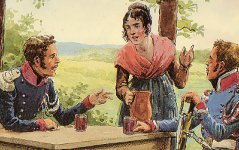 The Poles reached France and Paris. Dinners, parties, and other gayeties were treats to the
Poles after long marching and insufficient supplies.
Henri Lachoque describes their entry into France: "A third detachment appeared in January.
Passing through Chalons it ran afoul of the chief of police who reported:
'Each trooper is a law unto himself and races through the streets at full gallop.
Drunkenness is rife and discipline nonexistent.
Marshal Kellermann gave the Poles a warm welcome. He had known them of old
and spoke their language, being a veteran of their war of independence from Russia. ...
The Poles reached France and Paris. Dinners, parties, and other gayeties were treats to the
Poles after long marching and insufficient supplies.
Henri Lachoque describes their entry into France: "A third detachment appeared in January.
Passing through Chalons it ran afoul of the chief of police who reported:
'Each trooper is a law unto himself and races through the streets at full gallop.
Drunkenness is rife and discipline nonexistent.
Marshal Kellermann gave the Poles a warm welcome. He had known them of old
and spoke their language, being a veteran of their war of independence from Russia. ...
 The Poles met famous General Lasalle. An officer of the Poles wrote:
"It was in Lasalle's school that we learned outpost duty. We have kept a
precious memory of this general in whom all the lovable and imposing qualities of a
born marshal were combined ... He should have replaced
Murat to whom he was vastly superior ... "
The Poles met famous General Lasalle. An officer of the Poles wrote:
"It was in Lasalle's school that we learned outpost duty. We have kept a
precious memory of this general in whom all the lovable and imposing qualities of a
born marshal were combined ... He should have replaced
Murat to whom he was vastly superior ... "
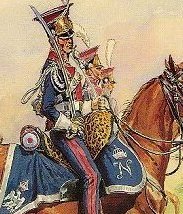
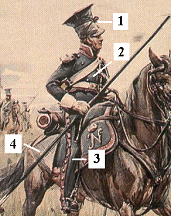 For parade the troopers did the following:
For parade the troopers did the following: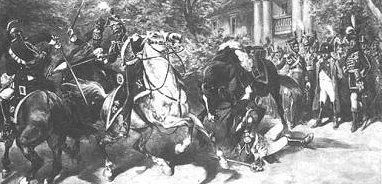 The Poles were eager to show their skill with their traditional weapon,
the lance. In 1809 in Vienna, NCO Jordan, called upon dragoons of Napoleon's
Guard, to "fight" him. Two battle-hardened veterans stepped out, he unhorsed both.
This friendly duel was watched by Napoleon, Marshal Murat, and staff officers.
(see picture -->)
The Poles were eager to show their skill with their traditional weapon,
the lance. In 1809 in Vienna, NCO Jordan, called upon dragoons of Napoleon's
Guard, to "fight" him. Two battle-hardened veterans stepped out, he unhorsed both.
This friendly duel was watched by Napoleon, Marshal Murat, and staff officers.
(see picture -->)


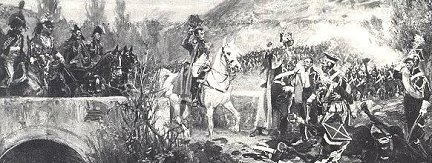 On picture: Awed Emperor salutes the wounded Poles after their charge at Somosiera 1808. Picture by Wojciech Kossak.
On picture: Awed Emperor salutes the wounded Poles after their charge at Somosiera 1808. Picture by Wojciech Kossak.
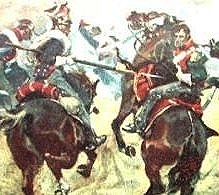 In 1809 "Napoleon wanted as many Austrian officers as possible captured and sent to his
headquarters; he also ordered prisoners
captured by Eugene at Raab escorted by Polish lancers, picked for their intelligence,
who were to chat casually with them and obtain all possible information concerning their
regiments."
(Elting - "Swords Around a Throne")
In 1809 "Napoleon wanted as many Austrian officers as possible captured and sent to his
headquarters; he also ordered prisoners
captured by Eugene at Raab escorted by Polish lancers, picked for their intelligence,
who were to chat casually with them and obtain all possible information concerning their
regiments."
(Elting - "Swords Around a Throne")
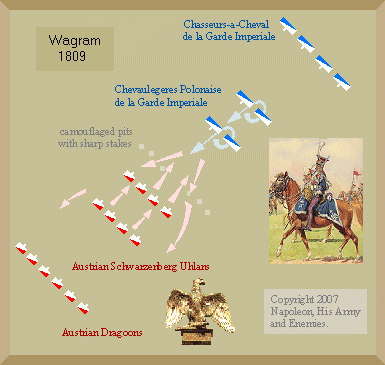 Kozietulski ordered: "Advance at the trot !" The Poles fought well, they captured 150
prisoners including several officers and the Duke of Auersberg. Majority of the prisoners were
Poles who no longer wanted to serve in the Austrian army. It was the greatest 'catch' the
regiment enjoyed.
Kozietulski ordered: "Advance at the trot !" The Poles fought well, they captured 150
prisoners including several officers and the Duke of Auersberg. Majority of the prisoners were
Poles who no longer wanted to serve in the Austrian army. It was the greatest 'catch' the
regiment enjoyed.
 In 1810 and 1811 the regiment rested and enjoyed good time in France.
Many lighthorsemen were awarded, for example Kozietulski received Legion d'Honneur and
the title of baron of Empire. Wincenty Krasinski was promoted to the rank of general.
In 1810 and 1811 the regiment rested and enjoyed good time in France.
Many lighthorsemen were awarded, for example Kozietulski received Legion d'Honneur and
the title of baron of Empire. Wincenty Krasinski was promoted to the rank of general.
 The regiment spent the winter of 1811-1812 very happily in Paris.
Chlapowski: "... the Emperor decided on his return from Holland to provide entertainment
for his much younger bride, and so every day there was a reception or ball, sometimes in the
Tuileries, sometimes at the house of one of his sisters ...
The regiment spent the winter of 1811-1812 very happily in Paris.
Chlapowski: "... the Emperor decided on his return from Holland to provide entertainment
for his much younger bride, and so every day there was a reception or ball, sometimes in the
Tuileries, sometimes at the house of one of his sisters ...
 One of our squadrons, which was escorting Murat in person, lost heavily on this occasion
as the King of Naples cared as little for his own safety as for that of anybody else. ...
we came several times upon Russian rearguard of Cossacks and Lifeguard Hussars, but they
never once stood to fight. All they did each time was sent out flankers to harry us, while
the main body retired. We caught a few red cossacks (Lifeguard Cossacks).
They are a very tall and powerful race."
One of our squadrons, which was escorting Murat in person, lost heavily on this occasion
as the King of Naples cared as little for his own safety as for that of anybody else. ...
we came several times upon Russian rearguard of Cossacks and Lifeguard Hussars, but they
never once stood to fight. All they did each time was sent out flankers to harry us, while
the main body retired. We caught a few red cossacks (Lifeguard Cossacks).
They are a very tall and powerful race."
 But the Cossacks approached with increasing boldness, firing with their ancient pistols.
As we sent nobody out to skirmish with them, they came closer and closer, shouting;
'Lachy !' (slang for Poles) when they discovered we were Polish.
But the Cossacks approached with increasing boldness, firing with their ancient pistols.
As we sent nobody out to skirmish with them, they came closer and closer, shouting;
'Lachy !' (slang for Poles) when they discovered we were Polish.
 In the Polish Guard Lancer Regiment served men from eastern parts of Poland who spoke some Russian language. These were used as translators or put into the advance guard. They would speak Russian to anybody they came across and pass themselves off as Russian troops. Some of the locals knew that the Russian army had uhlan regiments, so they mistook the Polish Guard for one of those units.
The Dutch 'Red Lancers' had no knowldge of Russian language, so General Colbert added 1 or 2 Poles to each Dutch outpost.
In the Polish Guard Lancer Regiment served men from eastern parts of Poland who spoke some Russian language. These were used as translators or put into the advance guard. They would speak Russian to anybody they came across and pass themselves off as Russian troops. Some of the locals knew that the Russian army had uhlan regiments, so they mistook the Polish Guard for one of those units.
The Dutch 'Red Lancers' had no knowldge of Russian language, so General Colbert added 1 or 2 Poles to each Dutch outpost.
 Near Malo-Yaroslavetz the Cossacks attacked Napoleon's headquarters at Gorodnia [Horodnia].
The only troops with the Emperor was the Duty Squadron of the Guard Lancers under Kozietulski.
Kozietulski's men threw themselves at the swarm of Cossacks, Kozietulski was pierced by
lance "which entered his shoulder as far as the bone." It was a dramatic fight. There
then appeared the Old Guard Horse Grenadiers in line formation and the Cossacks disappeared
into the forest.
(In Museum of the Polish Army in Warsaw is exhibited his uniform with the
visible hole in the sleeve and stained in blood). The Cossacks returned in large numbers and
surrounded the Red Lancers on three sides.
The Dutch lost more than 100 men and the Poles lost approx. 20 killed and wounded.
Near Malo-Yaroslavetz the Cossacks attacked Napoleon's headquarters at Gorodnia [Horodnia].
The only troops with the Emperor was the Duty Squadron of the Guard Lancers under Kozietulski.
Kozietulski's men threw themselves at the swarm of Cossacks, Kozietulski was pierced by
lance "which entered his shoulder as far as the bone." It was a dramatic fight. There
then appeared the Old Guard Horse Grenadiers in line formation and the Cossacks disappeared
into the forest.
(In Museum of the Polish Army in Warsaw is exhibited his uniform with the
visible hole in the sleeve and stained in blood). The Cossacks returned in large numbers and
surrounded the Red Lancers on three sides.
The Dutch lost more than 100 men and the Poles lost approx. 20 killed and wounded.
 Chlapowski writes: "This was the fault of General
Chlapowski writes: "This was the fault of General  After the battle of Krasne Napoleon moved toward Smolensk. Murat ordered the regiment
to follow him at the trot and then ordered to charge right in to the village occupied by Russian jagers. The Poles suffered 10 killed and wounded before they reached the center of the village.
The cavalry was unable to gallop in deep snow, they lost several horses to close range fire, came out the other side and formed up again. Napoleon was furious at Murat and sent a single infantry company (of Old Guard Foot Grenadiers) who took the village without a single shot.
The Foot Grenadiers also freed several Poles who had been unhorsed and taken prisoner by
the jagers. Chlapowski was greatly impressed with the Foot Grenadiers, saying that they "stood as solid as a wall."
After the battle of Krasne Napoleon moved toward Smolensk. Murat ordered the regiment
to follow him at the trot and then ordered to charge right in to the village occupied by Russian jagers. The Poles suffered 10 killed and wounded before they reached the center of the village.
The cavalry was unable to gallop in deep snow, they lost several horses to close range fire, came out the other side and formed up again. Napoleon was furious at Murat and sent a single infantry company (of Old Guard Foot Grenadiers) who took the village without a single shot.
The Foot Grenadiers also freed several Poles who had been unhorsed and taken prisoner by
the jagers. Chlapowski was greatly impressed with the Foot Grenadiers, saying that they "stood as solid as a wall."
 During retreat from Russia the Polish Guard Lancers and the French Guard Chasseurs formed
Napoleon's escort. Napoleon said to the Poles: "I count on you. In case of certain danger I want you to kill
me rather than let me be captured." The Poles responded: "We shall all be hacked to pieces
rather than permit anyone to approach you !"
The 7th Company of the Guard Lancers and the French Guard Chasseurs-a-Cheval formed Napoleon's escort and accompanied the Emperor through Lithuania. The rest of the Guard Lancer Regiment
escorted Emperor's money and baggage. Lachoque writes: "Dressed in a Polish costume consisting of a green pelisse
and a cap of marten fur, Napoleon had so far traveled in his closed carriage."
(Lachoque - "The Anatomy of Glory" p 251)
During retreat from Russia the Polish Guard Lancers and the French Guard Chasseurs formed
Napoleon's escort. Napoleon said to the Poles: "I count on you. In case of certain danger I want you to kill
me rather than let me be captured." The Poles responded: "We shall all be hacked to pieces
rather than permit anyone to approach you !"
The 7th Company of the Guard Lancers and the French Guard Chasseurs-a-Cheval formed Napoleon's escort and accompanied the Emperor through Lithuania. The rest of the Guard Lancer Regiment
escorted Emperor's money and baggage. Lachoque writes: "Dressed in a Polish costume consisting of a green pelisse
and a cap of marten fur, Napoleon had so far traveled in his closed carriage."
(Lachoque - "The Anatomy of Glory" p 251)
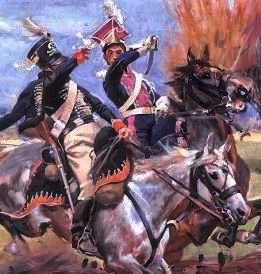 Picture: Guard Lighthorseman vs Prussian Death Head's
hussar, by W.Kossak. This picture is not authentic in its details but is evidence
of the enduring interest in the regiment.
Picture: Guard Lighthorseman vs Prussian Death Head's
hussar, by W.Kossak. This picture is not authentic in its details but is evidence
of the enduring interest in the regiment.
 On Sept 16th 1813 at Peterswalde the Guard Lancers put to rout the Prussian Life Hussars. NCO Mierzejewski wounded Colonel Friedrich von Blucher, a relative of
the well-known General Blucher, and took him prisoner. Officer Jankowski was awarded with
a star of the Légion d'honneur [Legion of Honor] and the whole regiment won fame.
On Sept 16th 1813 at Peterswalde the Guard Lancers put to rout the Prussian Life Hussars. NCO Mierzejewski wounded Colonel Friedrich von Blucher, a relative of
the well-known General Blucher, and took him prisoner. Officer Jankowski was awarded with
a star of the Légion d'honneur [Legion of Honor] and the whole regiment won fame.
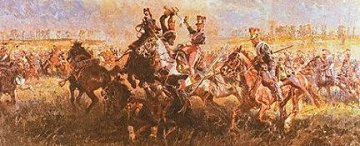 In May near Zgorzelec (Gorlitz) General Walther was ordered to take all regiments of the
cavalry of Imperial Guard and move to the right. Walther's force met Russian rearguard at Reichenbach.
Chlapowski describes the actions of his regiment: "We marched off by platoons, and crossing the fields at a trot we covered about 0.5 mile until we came to a deep ditch
full of trees. There we had to halt and cross slowly in pairs. As soon as my 2 squadrons had crossed, General Lefebvre-Desnouettes ...
ordered me to see off a mass of Cossacks that had appeared to our front. I formed line with my two squadrons and advanced toward the enemy.
The Cossacks retired before us firing their side arms. We followed them for 300 paces, while
the next two squadrons under Jerzmanowski (in 1815 Elba Squadron) crossed the ditch behind us.
We came upon a second ditch ... The Cossacks halted on the far side, and kept up a lively
fire from behind the trees.
In May near Zgorzelec (Gorlitz) General Walther was ordered to take all regiments of the
cavalry of Imperial Guard and move to the right. Walther's force met Russian rearguard at Reichenbach.
Chlapowski describes the actions of his regiment: "We marched off by platoons, and crossing the fields at a trot we covered about 0.5 mile until we came to a deep ditch
full of trees. There we had to halt and cross slowly in pairs. As soon as my 2 squadrons had crossed, General Lefebvre-Desnouettes ...
ordered me to see off a mass of Cossacks that had appeared to our front. I formed line with my two squadrons and advanced toward the enemy.
The Cossacks retired before us firing their side arms. We followed them for 300 paces, while
the next two squadrons under Jerzmanowski (in 1815 Elba Squadron) crossed the ditch behind us.
We came upon a second ditch ... The Cossacks halted on the far side, and kept up a lively
fire from behind the trees.
 We continued at a walk for another 300 paces, and I instructed both squadrons to go hell for
leather as soon as I sounded the charge. They were not lower their lances, however, but
should point them at the enemy's faces. ...
We continued at a walk for another 300 paces, and I instructed both squadrons to go hell for
leather as soon as I sounded the charge. They were not lower their lances, however, but
should point them at the enemy's faces. ...
 "But shortly I saw a second enemy line approaching, all of them uhlans. I stopped my horse,
and had only begun to restore order to the ranks when this line began a charge. I was obliged
to reform as best I could, 'Forward ! March !' otherwise they
would have caught us stationary, which you should never let the enemy do. ...
As they charged, the Russian uhlans lost some of their dressing, but they still came on and
broke into our line. They outnumbered us, and we should certainly have been beaten if
Jerzmanowski had not come up with
his two squadrons. He was the very best field officer in the regiment ... and with a fine,
cool judgement. At just the right moment he struck the enemy from our left flank, having come
up close at a walk to save energy for his charge.
"But shortly I saw a second enemy line approaching, all of them uhlans. I stopped my horse,
and had only begun to restore order to the ranks when this line began a charge. I was obliged
to reform as best I could, 'Forward ! March !' otherwise they
would have caught us stationary, which you should never let the enemy do. ...
As they charged, the Russian uhlans lost some of their dressing, but they still came on and
broke into our line. They outnumbered us, and we should certainly have been beaten if
Jerzmanowski had not come up with
his two squadrons. He was the very best field officer in the regiment ... and with a fine,
cool judgement. At just the right moment he struck the enemy from our left flank, having come
up close at a walk to save energy for his charge.
 "Then another regiment regiment of Russian uhlans appeared ... and advanced toward us in line.
But when it was still 500 paces away it broke into a gallop.
Lefebvre-Desnouettes ... again wanted us to counter-charge.
Jerzmanowski, who knew the general very well, told him there was no point in charging, as the enemy
had begun to gallop far too soon; they would soon lose formation and would never reach us.
Sure enough, their line shortly broke up, a few dozen pulled ahead and the majority began to
slow down. Nobody came any closer to us than 100 paces. ... General ordered two platoons to form skirmish order and go out to meet them.
They brought back half a dozen or more of the slowest horsemen. We discovered they weren't lances, but regular Ukrainian Cossacks.
... The Cossacks had retreated and were reforming a very long way away from us.
This proved them to be very young recruits, whose officers were probably no better.
... Now General Walther appeared, and after complimenting us on our charge he ordered us to march off by platoons to the left and advance up the slope ... "
"Then another regiment regiment of Russian uhlans appeared ... and advanced toward us in line.
But when it was still 500 paces away it broke into a gallop.
Lefebvre-Desnouettes ... again wanted us to counter-charge.
Jerzmanowski, who knew the general very well, told him there was no point in charging, as the enemy
had begun to gallop far too soon; they would soon lose formation and would never reach us.
Sure enough, their line shortly broke up, a few dozen pulled ahead and the majority began to
slow down. Nobody came any closer to us than 100 paces. ... General ordered two platoons to form skirmish order and go out to meet them.
They brought back half a dozen or more of the slowest horsemen. We discovered they weren't lances, but regular Ukrainian Cossacks.
... The Cossacks had retreated and were reforming a very long way away from us.
This proved them to be very young recruits, whose officers were probably no better.
... Now General Walther appeared, and after complimenting us on our charge he ordered us to march off by platoons to the left and advance up the slope ... "
 There was unwritten law to not maneuver in front of enemy's cavalry - too often it
ended up in a disaster. Only very few regiments attained the perfection of changing the
formation at gallop without losing its order and in front of the enemy. At
Reichenbach the Guard lancers got under artillery fire, made half-turn and crushed
enemy's cavalry without losing its alignment. Chlapowski writes:
There was unwritten law to not maneuver in front of enemy's cavalry - too often it
ended up in a disaster. Only very few regiments attained the perfection of changing the
formation at gallop without losing its order and in front of the enemy. At
Reichenbach the Guard lancers got under artillery fire, made half-turn and crushed
enemy's cavalry without losing its alignment. Chlapowski writes:
 They stopped, turned right around, and began to retreat just as we fell upon them.
As might be expected, they routed.
Their slowest troopers fell into our hands and we'd have captured more
if their infantry had not been in column close by. ... We camped that night at the spot where we had captured these troopers.
They turned out to be from the Prussian Guard Cavalry Regiment, and included hussars, dragoons, and a few
Berlin cossacks, whose beards were longer than those of the Don Cossacks. ... On May 30 we went with Flahaut (Napoleon's ADC), on
a reconnaissance toward Jaworz ... Flahaut climbed to the top of a windmill, from which he could see several Cossack regiments ..."
They stopped, turned right around, and began to retreat just as we fell upon them.
As might be expected, they routed.
Their slowest troopers fell into our hands and we'd have captured more
if their infantry had not been in column close by. ... We camped that night at the spot where we had captured these troopers.
They turned out to be from the Prussian Guard Cavalry Regiment, and included hussars, dragoons, and a few
Berlin cossacks, whose beards were longer than those of the Don Cossacks. ... On May 30 we went with Flahaut (Napoleon's ADC), on
a reconnaissance toward Jaworz ... Flahaut climbed to the top of a windmill, from which he could see several Cossack regiments ..."
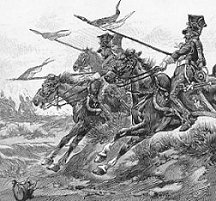 In 1814 as the Emperor struggled to thwart the advance of the Russian, Prussian and
Austrian armies on Paris, his tactics put the Polish lancers to the most gruelling of
physical and psychological tests. They distinguished themselves in every engagement
they fought: Brienne, Montmirail, Vauchamps, Montereau, Craonne, Rheims and
In 1814 as the Emperor struggled to thwart the advance of the Russian, Prussian and
Austrian armies on Paris, his tactics put the Polish lancers to the most gruelling of
physical and psychological tests. They distinguished themselves in every engagement
they fought: Brienne, Montmirail, Vauchamps, Montereau, Craonne, Rheims and
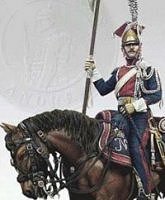 When Napoleon was forced to abdicate, Jerzmanowski was chosen as the commander of cavalry volunteers who were allowed to accompany the Emperor to Elba Island.
(Jerzmanowski didn't like one thing about Napoleon: the Emperor was unable to correctly pronounce his name ;=)
When Napoleon was forced to abdicate, Jerzmanowski was chosen as the commander of cavalry volunteers who were allowed to accompany the Emperor to Elba Island.
(Jerzmanowski didn't like one thing about Napoleon: the Emperor was unable to correctly pronounce his name ;=)
